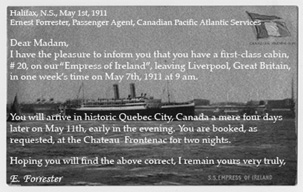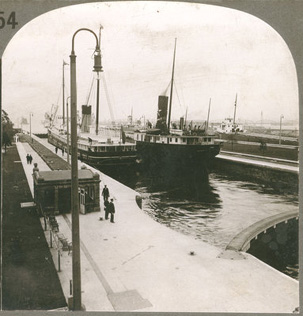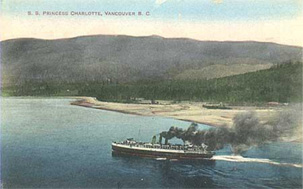On Canada's Water: Parks Canada Celebrates New Beginnings
This month, come celebrate Parks Canada's centennial by visiting
four national marine conservation areas (NMCA): Saguenay-St.
Lawrence Marine Park, Fathom Five National Marine Park, Lake
Superior National Marine Conservation Area, and Gwaii Haanas
National Marine Conservation Area Reserve and Haida Heritage Site.
These areas represent a new chapter in the Parks Canada network of
national parks and national historic sites, and they encompass both
vast natural features as well as unique cultural heritage.
The Canadian Register of Historic Places celebrates Parks Canada's
centennial by looking back at Canada's marine heritage associated
with these NMCAs.
A century ago, tourists travelling by passenger ship experienced
vast waterways, recording their impressions of seas and lakes in
their diaries. Just imagine yourself travelling then...
Springtime in 1911 and you are a well-to-do English woman who wants
to travel across Canada. You hear that Canadian Pacific Railway is
promoting travel by rail and steamship. You read the catchy
slogans: Spans the World! World's Greatest Travel System! The
New Highway to the Orient! You see colourful posters, and the
romance of travel excites you. You contact your local CPR
passenger agent to book your trip.
You receive a ticket and the following letter: 
You board your ship on May 7, 1911, and during the four days at
sea, you purchase a leather bound travel diary. You start taking
notes towards the end of the passage. The diary has the following
embossed title:
My Cruise Round the World with Empress of Ireland and Other CPR Steamships,
1911-1912
May 11, 12pm ...After uneventful passage across
Atlantic, now sailing down St. Lawrence River... As the vessel
rounds the Gaspé Peninsula I glimpse a pod of white whales known as
"belugas"... Continued on past Rimouski, Trois Pistoles, and the
lighthouses on Ile Rouge and Ile Verte, the first lighthouse built along
the St. Lawrence. 
May 11, 2pm...Nearing the confluence of the St.
Lawrence and Saguenay Rivers, vessel slowed considerably and I
noticed shipping traffic had significantly increased...I approached
a gentleman to inquire about the sudden maritime activity. ..He
informed me the most likely reason for the traffic would be the
booming lumber industry along the Saguenay and Chicoutimi
Rivers...Pulp and paper mills in the area are dependent on water
for power and for shipping goods...The recently opened Chicoutimi Pulp Mill is thriving and quickly
becoming the largest producer of pulp in the country...At these
words the man chuckled and added that he hoped his new mills in the
Beauce Region and in Maine would give the Compaginie de pulpe de
Chicoutimi a run for its money.
At the mouth of the Saguenay River we pass a stunning village,
which my CPR Guidebook says is Tadoussac, the site of a
17th-century French trading post and the oldest continuously
inhabited settlement in Canada…the stark contrast between the
vivid, green landscape, the deep, blue waters, and the small, red
and white chapel is absolutely stunning…I hope these
vistas are preserved for many years to come.
Took in this beautiful scenery length of the trip...arrived in
bustling Quebec City.
You receive another letter about the rest of your journey,
which you place in your travel diary: 
May 15, 2 pm...Whirlwind days in Quebec and
Toronto now over...though enjoyable, delighted to be on the fast
train to Owen Sound...
May 15, 4pm...Everything has worked like
clockwork... Owen Sound has been CPR's steamship headquarters since
service began on May 11, 1884. This was once the only
Canadian link between the two finished sections of the railway at
that time...S.S. Assiniboia is one of five CPR steamships providing
service five days a week to "The Lakehead" on the western shores of
Lake Superior...
May 15, 6 pm...Wandering around ship...lovely
staterooms on two decks, a flower lounge two decks high with
stained glass skylight! Lots of potted plants, dining saloon
with seating for over a 100 people...a ballroom lounge... There are
apparently 300 people on board, mostly immigrants heading west to
settle on the Prairies...CPR guidebook tells me that journey by
rail along the north shore of Lake Superior takes 100 hours from
Toronto to The Lakehead, compared to less than 48 scenic hours on
the water...what speed!
May 15, 7 pm...Have sailed past numerous other
passenger and packet freighters and am told there are over
100 of these ships sailing these waters...what a busy place!
We pass several lighthouses at edge of Georgian Bay and Lake
Huron...Griffith Island, Big Tub, Flowerpot Island, Cove Island names... built by Canadian
government between 1855 and 1885 to guide ships through fog and
past dangerous shoals...numerous schooners still wrecked...scenic
islands dot the spectacular blue-green waters here...water very
shallow, CPR guidebook says, only five fathoms...here is a
postcard of the Flower Pot lighthouse:
... I notice a young man on board who stands on the main deck
with his paints, brush and easel who seems very inspired by the
scenery...he is at my dinner table later and is introduced to us as
Mr. Lawren Harris. Overnight, ship
heads northwest, passing Manitoulin Island...guided by lighthouses
and mournful fog horn in Mississagi Straight...sails
through Sault Saint Marie Canal (built 1894) which
links Lake Huron with Lake Superior. .. Here is a photo of the
canal:
May 16, 10 am...Lake Superior: A vast inland
sea...huge!...though lots of other ships plying these waters, feels
like we're the only boat here...a clear calm morning,
apparently a rarity in these parts...
...see the north shore on the horizon...friendly CPR crew member
reminds me that on this date in 1885 - that's just twenty six years
ago! he says - the last spike of the Ontario portion of the railway
was driven down near the small town of Schreiber ...my CPR guidebook says this
ended a number of extremely difficult years for the CPR... tracks
and other supplies shipped in to small ports such as
Rossport, Nipigon, and Terrace Bay, construction involved blasting
away sheer rock faces, building tunnels, and spanning rivers with
long trestle bridges...
lighthouses then built...such achievements make one happy to be
part of this new, more modern age...railway finally linked isolated
communities across Canada helping to open up this relatively
inaccessible region to logging, fishing, and mining
interests....
May 16, 5pm...the painter Harris seems inspired
by landscape and is painting vigorously; hear him exclaim that
we'll soon pass the wild forested peninsula called the "Sleeping
Giant."
...my CPR guidebook says there was silver mining here in the
1870s...also says we might see some aboriginals in their canoes...haven't seen any
yet...how have all these changes affected these people? Such
stark beauty! How could anyone apart from the birds and fish live
in this wild watery place?
May 17, 8 am...Finally, arrive in Port
Arthur....After comparative solitude of the lake, this bustling
travel hub and commercial gateway comes as a surprise! While
leaving my ship, am intrigued by an octagonal Asian-inspired pagoda with a carved beaver! 
I am sitting in my launching point for the West: cosmopolitan Union Station, which my CPR guidebook says was
built only last year in 1910...it has a lovely garden out front
filled with pansies beginning to bloom in the May sunshine...
May 20, 8pm...Uneventful trip across
the Prairies to Vancouver with brief stop at bustling Winnipeg Railway Station ...stayed overnight
at the "Europe Hotel" in Gastown, a neighbourhood in booming
Vancouver...boarding the Princess Charlotte this afternoon
for three day journey to Prince Rupert...Now aboard the ship
and following lush British Columbia coastline, advancing north via
famed "Inside Passage" towards Prince Rupert.
May 23, 10am...Was gazing out across Hecate
Strait and suddenly became mesmerized by larger group of islands
off in distance...As I looked out over the water, a peculiar young
woman appeared by my side...she proceeded to tell me the most
wonderful stories about her visits to northern aboriginal villages
and showed me sketches and paintings of her travels...she was on
her way to the Queen Charlotte Islands, known as Haida Gwaii, to
document the life and culture of the Haida
people who had inhabited the islands for over 10,000 years...she
hoped to visit the remaining traditional villages and longhouses and learn more about Haida culture, a
way of life endlessly connected to the water, trees, and
mountains.
May 23, 4pm...Vessel approaching Prince Rupert
Harbour, near here is the fish cannery known as the North Pacific Canning Company; and we pass by
a lighthouse on Triple Island ...As this leg of the journey
comes to a close, I wonder if future travellers will experience the
beauty and grandeur of this great marine adventure?
And today, you too can follow the voyage of our 1911
tourist.
On the St. Lawrence River near the Saguenay-St. Lawrence Marine Park, you would
still see some of the same wild-looking landscape, reverting back
to a more natural state after many years of intensive resource
extraction. You might want to stop at the museum near the
wreck of the Empress of Ireland. The ship is now a national
historic site, and is a wreck below water due to a July 1914
collision with another ship in thick fog.
On the Great Lakes, you would still see some of the same
lighthouses, and in Fathom Five National Marine Park, you might go
diving below the NMCA's famed blue-green waters to see
shipwrecks. Though a century of mining, logging, and
fishing have occurred on Lake Superior, it is still a relatively
unspoiled and quiet place. Near Rossport, the August 1911
shipwreck of the Gunilda is now preserved within the boundaries of
Lake Superior National Marine Conservation Area
and heritage lighthouses - including Battle Island Light
Station - are on islands in the NMCA. Drive the Trans-Canada
highway along the lake's edge or hike along the nearby Voyageur
Trail, and you will see railway stations preserved in places like
Schreiber, aboriginal activities commemorated near Pic River and
see the inspiring CPR engineering work of the trestle rail bridge
over Nipigon River near Nipigon. The bustling city of Thunder
Bay still welcomes weary travellers, and is now one of the official
Parks Canada gateways to the marine conservation area.
On the coast of British Columbia, you can take a ship - either a
giant cruise liner or smaller provincial ferry or state ferry -
north through the "inside passage" to Prince Rupert and then on to
Alaska. Despite numerous gold rushes and tourist ships
passing by over the past century, the coastal waters and islands
are still relatively untouched. The recently established Gwaii Haanas National Marine Conservation Area
Reserve and Haida Heritage Site, off the Queen Charlotte
Islands, protects land, water and aboriginal heritage. This
unique and all-encompassing protective status may be a step towards
how future NMCA's in Canada are established. The near future
belongs to the designation and protection of new NMCA's, where new
experiences await our discovery!